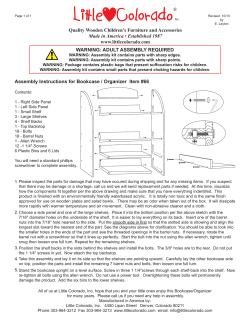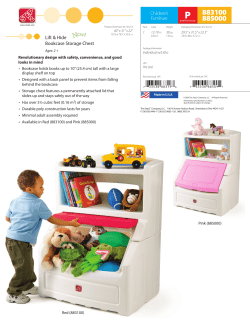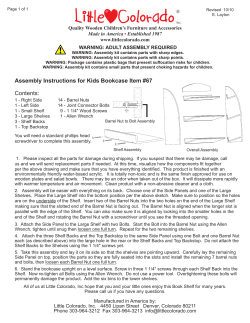
Build a bookcase M ItrePlAn PrOJeCt PlAnner
MItrePlAn PrOJeCt PlAnner Build a bookcase • An easy-to-follow guide to achieving a perfect result. • Outlines all the tools you will need for the job. • Includes a materials checklist. PLEASE NOTE: Before starting this project or buying any materials, it is worth your time to read all steps thoroughly first to be sure you understand what is required. Mitre 10 is proudly Australian owned. #24 mitre10.com.au MIGhTY TOOLS fOR YOuR MITREPLAN ✓ MIGhTY hELPfuL ChECkLIST Timber Be sure to specify dressed all round (DAR) when purchasing. Lengths can be supplied sufficient for you to cut the required pieces. When ordering, be sure to say that your needs are for lengths from which 780mm pieces will be cut. Or, you can order cut-to-length at extra cost, ready to assemble. PRICE ORDER 5 pieces 190 x 19 x 780mm 1 kickboard 90 x 19 x 780mm 1 backing sheet 810 x 690 x 4mm pine ply Power drill and bits Power saw or hand saw Power sander and sandpaper Measuring tape or ruler Pencil Carpenter’s square Adjustable pipe clamps Screwdriver hardware 10 – 50mm x 8 gauge counter sunk wood screws and 10 – 9.5mm screw head button caps (refer Step 1) or 4 – 5mm shelf supports 3 – 22 x 22mm angle brackets 6 – 16mm x 6 gauge angle bracket screws Pkt. 20mm bullet head nails to fix backing sheet Clear pine finish or pigment stain Verbal quotes are indicative only. Written quotes on materials are available upon request from your Mitre 10 store. An alternative This bookcase can also be built with particleboard, which is generally less expensive than timber. It’s available in a range of standard sheet sizes with either a plain finish for painting, or veneered with realistic woodgrain patterns and colours that need no finishing. However, any cut front edges will need to be disguised to give a clean finish – a matching pre-glued edging that you simply iron on is available. A single particleboard sheet 1200 x 900 x 18mm will provide all pieces with little wastage. If screwing together, be sure to ask for screws with a thread specially designed for particleboard. And don’t hesitate to seek advice and assistance at your Mitre 10 store. Visit mitre10.com.au for more S MIGhTY hELPfuL hINTS TOaMAkE Make place ThE jOb EASIER to store your stories ■ Measuring is easy, materials withDouble help are– expensive. checkfrom all measurements and markings Mitre 10.piece before you cut any Build a bookcase of timber. here’s handsome ■ To make asure the holes way to store your youfavourite drill in the books. sides for All shelf you need are support are straight, lay average handyperson skills, the right the sides flat and stand a tools, and a few spare hours. We’ve carpenter’s square upright chosen from close to the to drillbuild while this doingbookcase it. Radiata Pine for its attractive natural ■ When cutting the backing knotty appearance and colour. It’s one piece to fit, cut it up to 5mm ofthan thethe easiest less overall timbers height andto work with. Step 1: Choose your joint fittings Today, you don’t have to be a cabinet or furniture maker to join timber securely. There are now many concealed assembly aids that you can buy to achieve a professional result using the simplest of all joints – the ‘butt’ joint (the joining of two pieces at right angles to each other). These aids not only offer you a quick and easy way to join timber, but they allow you to easily dismantle your bookcase for storage or moving. Some assembly aids you can use for this project include matching pine button caps and plastic block fittings. The pine button caps allow you to simply screw the pieces together (Fig. 1) and then conceal the screw heads neatly and decoratively to give your bookcase a professional finishing touch. Plastic block fittings (Fig. 2), come in two parts that are separately screwed to the two pieces that you’re joining. A screw or bolt is then inserted to clamp the two parts together. Removal of this single screw or with an adjustable centre shelf. allows you to easily the pieces. The image shown bolt is a guide only to what can bedismantle achieved using this planner. ■ The jaws of clamps can It’s suitable for most hardbacks. mark the surface of timber or but Prevent you can vary the dimensions IMPORTANT: ThisStep project has materials been produced to provide 2: planner Prepare board. thiseasily by putting information and our experienced available toyou answer to suit books of any example, a scrap block of timber on size. forbasic If you’ve ordered yourstaff pineare cut-to-length, can any questions you may proceed have. However, this to information is provided for use either side of the pieces to include be standard pine sizes 140mm immediately the next step. If not, you’ll find on the understanding that Mitre 10 is not liable for any loss or damage clamped and under the jaws of making your bookcase easier if you cut and prepare all widths, ideal for pocket books. which is suffered or incurred (including but not limited to indirect or theOr clamp. pieces first. choose 240mm width if you have consequential loss), for any personal injury or damage to property suffered Startofby measuring out the first piece 780mm long mostly largethe books. or sustained as a result using the information contained in this MitrePlan ■ When sawing, waste and10 pencil a line across usingtradesperson, your Project Planner. Mitre advises you to callthein board a qualified must be supported and kept The choice What’s more, such as an electrician or plumber, where expert services are on required, carpenter’s square. Cut the board to length the level with the restisofyours. the board and to independently assess safetyline. precautions thatsame will need to be you’ll get hand. a realOn kick outside of any the ruled Then do the for the with your free longout of building followed prior to using the information pieces of waste,with get a the helper remaining four pieces in and kickboard. Check with it yourself, help of the this MitrePlan Project Planner. to step-by-step take the weight, MitrePlan but make guide. your carpenter’s square that all cut ends are square. sure your friend doesn’t lift the You’llbeachieve WARNING: There may by lawsmore or accurate results here by cutting board or the saw will jam. the or timber a sharp handsaw. regulations of councils otherwith statutory bodies that you must comply with when ■ Always fig. 1match the size of Step 3: Pre-drill holes following this MitrePlan Project Planner. the screwdriver to the size of Before assembling, drill the holes for the top and the screw – the width of the bottom shelf positions on the inside of both sides. blade should be the same as the screw slot. And you’ll find Measure up 109mm from the bottom of each side to it easier if you use the longest Your local MITRE Store is:front kickboard (90mm) and allow for 10 the height of the screwdriver possible – you’ll the thickness of the bottom shelf (19mm), and rule a get more leverage that way. line across (Fig. 3). ■ When using power tools, Next, measure down 24mm from the top of each side always use suitable safety and rule a similar line across. The top shelf will be protection including ear muffs, fixed 5mm down the sides and this line represents the goggles and mask if necessary. bottom of the top shelf (Fig. 3). And never use power tools on Now check that your measurements and markings on a wet or damp floor. each side are the same. Then decide where you want the middle shelf to be positioned and measure and mark this point on both sides. width of your bookcase. This The design is basically a simple box, way, when you nail on it, it will 820 x 780 x 190mm, beapproximately much less noticeable. fig. 2 Lay the pieces flat and drill 5mm holes 10mm deep for the shelf supports (Fig. 3). To make sure the holes you drill are straight, stand your carpenter’s square upright fig. 3 close to the drill while you’re doing it. Wrap a piece of tape around the drill bit to the required depth to prevent you from drilling through to the other side. Drill as many shelf adjustment holes as you like. But be careful to locate all holes opposite each other so the shelf will sit level on the four pins in any position. fig. 6 Step 4: Put it together Whether using timber screws or plastic block fittings, the top is set down 5mm and the bottom up 90mm (Fig. 4). Timber Screws & Caps If using 50mm x 8 gauge screws, clamp the top and bottom shelves into place. Check that all edges are flush and that the shelves are level. You may need an extra pair of hands here to hold the pieces together until you get them firmly clamped. It’s also a good idea to place a piece of scrap timber under the jaws of the clamp on both sides to prevent it from marking the surface of the board. fig. 4 block fittings Two block fittings are screwed into position on the inside of each side underneath both the top and bottom shelves. Measure in 30mm from the front and back on the bottom of the shelves and pencil in a line. Place the edge of one part of the block fitting inside the drawn line and flush with the end of the board. Then screw it into position – first drilling the holes slightly smaller than the diameter of the screw. Do the same on the sides with the other part of the block fittings and fix the parts together with a single screw or bolt (Fig. 6). It’s that easy. Step 5: Add the kickboard fig. 7 When the sides, top and bottom are firmly fixed together, turn the box frame upside down and fit the kickboard to support the bookcase at the front and provide toe room. The kickboard fits between the two sides, set in up to 25mm from the front. Secure it to the underside of the bottom shelf with an angle bracket and screws at both ends (Fig. 7). Now measure in 40mm from the front and back on the outside where each shelf joins the sides. Drill two holes slightly smaller than the diameter of the 8 gauge screw through the sides and into each shelf to a depth of 55mm (Fig. 5). Follow this by drilling 9.5mm holes through the sides only to a depth of 5mm. Then fix the top and bottom shelves to the sides with the screws. Cover the holes and screws with 9.5mm pine button caps to give a neat finish. Also drill a hole through each side into approximately the centre of the kickboard and fix with screws and a button cap as before. Or, if you’re using blocks, give it extra strength with fittings set about 150mm in from either end. Step 6: Add the back Now, lay the unit face down and measure diagonally to opposite corners. When both measurements are exactly the same, your bookcase is square. Then measure and cut the backing sheet to fit from the top shelf to the bottom shelf and nail onto the shelves and both sides. If the back of the bookcase rests on the wall’s skirting board, measure the board’s height and depth and cut out a corresponding piece from each side of the bookcase. This will allow it to fit on top of the skirting board and sit flush with the wall (Fig. 7). fig. 5 Step 7: fit the shelf Finally, push the shelf supports into the holes that you previously drilled in the sides. Then simply place your shelf on them (Fig. 8). If you find it’s too high or too low for the books you want to store, it’s an easy matter to adjust the shelf by moving the supports to the holes at the required height. Step 8: The finishing touch Now all that’s left is to give your new pine bookcase a protective coat. You could paint it, but that would hide the timber’s natural rich amber colour. So instead, you may prefer to use a clear Pine Finish which brings out the timber’s true beauty while giving it a tough, satin finish. If you do want colour to mix or match with existing furniture or to add a bright, cheery note to a child’s room, choose a Pigment Stain. They add colour without hiding the timber’s grain – and they’re available in decorator colours as well as timber tones. fig. 8 The choice is yours. But before coating your bookcase, be sure to sand the entire surface to a smooth finish. And be sure to sand with the grain, particularly if using a clear finish – sanding across the grain will leave scratches. Then remove all traces of dust or dirt with a damp cloth to achieve the best result. MIGhTY hELPfuL hINTS TO MAkE ThE jOb EASIER Build a bookcase ■ Measuring is easy, materials are expensive. Double check all measurements and markings before you cut any piece of timber. ■ To make sure the holes you drill in the sides for shelf support are straight, lay the sides flat and stand a carpenter’s square upright close to the drill while doing it. ■ When cutting the backing piece to fit, cut it up to 5mm less than the overall height and width of your bookcase. This way, when you nail on it, it will be much less noticeable. ■ The jaws of clamps can mark the surface of timber or board. Prevent this by putting a scrap block of timber on either side of the pieces to be clamped and under the jaws of the clamp. ■ When sawing, the waste must be supported and kept level with the rest of the board with your free hand. On long pieces of waste, get a helper to take the weight, but make sure your friend doesn’t lift the board or the saw will jam. ■ Always match the size of the screwdriver to the size of the screw – the width of the blade should be the same as the screw slot. And you’ll find it easier if you use the longest screwdriver possible – you’ll get more leverage that way. ■ When using power tools, always use suitable safety protection including ear muffs, goggles and mask if necessary. And never use power tools on a wet or damp floor. The image shown is a guide only to what can be achieved using this planner. IMPORTANT: This project planner has been produced to provide basic information and our experienced staff are available to answer any questions you may have. However, this information is provided for use on the understanding that Mitre 10 is not liable for any loss or damage which is suffered or incurred (including but not limited to indirect or consequential loss), for any personal injury or damage to property suffered or sustained as a result of using the information contained in this MitrePlan Project Planner. Mitre 10 advises you to call in a qualified tradesperson, such as an electrician or plumber, where expert services are required, and to independently assess any safety precautions that will need to be followed prior to using the information in this MitrePlan Project Planner. WARNING: There may be by laws or regulations of councils or other statutory bodies that you must comply with when following this MitrePlan Project Planner. Your local MITRE 10 Store is:
© Copyright 2025












